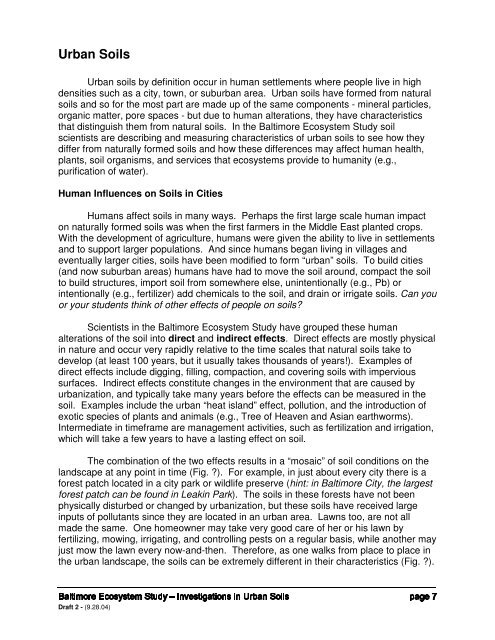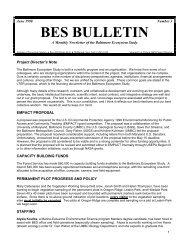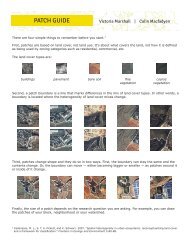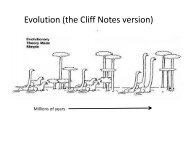Investigations in Urban Soils - Baltimore Ecosystem Study
Investigations in Urban Soils - Baltimore Ecosystem Study
Investigations in Urban Soils - Baltimore Ecosystem Study
Create successful ePaper yourself
Turn your PDF publications into a flip-book with our unique Google optimized e-Paper software.
<strong>Urban</strong> <strong>Soils</strong><br />
<strong>Urban</strong> soils by def<strong>in</strong>ition occur <strong>in</strong> human settlements where people live <strong>in</strong> high<br />
densities such as a city, town, or suburban area. <strong>Urban</strong> soils have formed from natural<br />
soils and so for the most part are made up of the same components - m<strong>in</strong>eral particles,<br />
organic matter, pore spaces - but due to human alterations, they have characteristics<br />
that dist<strong>in</strong>guish them from natural soils. In the <strong>Baltimore</strong> <strong>Ecosystem</strong> <strong>Study</strong> soil<br />
scientists are describ<strong>in</strong>g and measur<strong>in</strong>g characteristics of urban soils to see how they<br />
differ from naturally formed soils and how these differences may affect human health,<br />
plants, soil organisms, and services that ecosystems provide to humanity (e.g.,<br />
purification of water).<br />
Human Influences on <strong>Soils</strong> <strong>in</strong> Cities<br />
Humans affect soils <strong>in</strong> many ways. Perhaps the first large scale human impact<br />
on naturally formed soils was when the first farmers <strong>in</strong> the Middle East planted crops.<br />
With the development of agriculture, humans were given the ability to live <strong>in</strong> settlements<br />
and to support larger populations. And s<strong>in</strong>ce humans began liv<strong>in</strong>g <strong>in</strong> villages and<br />
eventually larger cities, soils have been modified to form “urban” soils. To build cities<br />
(and now suburban areas) humans have had to move the soil around, compact the soil<br />
to build structures, import soil from somewhere else, un<strong>in</strong>tentionally (e.g., Pb) or<br />
<strong>in</strong>tentionally (e.g., fertilizer) add chemicals to the soil, and dra<strong>in</strong> or irrigate soils. Can you<br />
or your students th<strong>in</strong>k of other effects of people on soils?<br />
Scientists <strong>in</strong> the <strong>Baltimore</strong> <strong>Ecosystem</strong> <strong>Study</strong> have grouped these human<br />
alterations of the soil <strong>in</strong>to direct and <strong>in</strong>direct effects. Direct effects are mostly physical<br />
<strong>in</strong> nature and occur very rapidly relative to the time scales that natural soils take to<br />
develop (at least 100 years, but it usually takes thousands of years!). Examples of<br />
direct effects <strong>in</strong>clude digg<strong>in</strong>g, fill<strong>in</strong>g, compaction, and cover<strong>in</strong>g soils with impervious<br />
surfaces. Indirect effects constitute changes <strong>in</strong> the environment that are caused by<br />
urbanization, and typically take many years before the effects can be measured <strong>in</strong> the<br />
soil. Examples <strong>in</strong>clude the urban “heat island” effect, pollution, and the <strong>in</strong>troduction of<br />
exotic species of plants and animals (e.g., Tree of Heaven and Asian earthworms).<br />
Intermediate <strong>in</strong> timeframe are management activities, such as fertilization and irrigation,<br />
which will take a few years to have a last<strong>in</strong>g effect on soil.<br />
The comb<strong>in</strong>ation of the two effects results <strong>in</strong> a “mosaic” of soil conditions on the<br />
landscape at any po<strong>in</strong>t <strong>in</strong> time (Fig. ?). For example, <strong>in</strong> just about every city there is a<br />
forest patch located <strong>in</strong> a city park or wildlife preserve (h<strong>in</strong>t: <strong>in</strong> <strong>Baltimore</strong> City, the largest<br />
forest patch can be found <strong>in</strong> Leak<strong>in</strong> Park). The soils <strong>in</strong> these forests have not been<br />
physically disturbed or changed by urbanization, but these soils have received large<br />
<strong>in</strong>puts of pollutants s<strong>in</strong>ce they are located <strong>in</strong> an urban area. Lawns too, are not all<br />
made the same. One homeowner may take very good care of her or his lawn by<br />
fertiliz<strong>in</strong>g, mow<strong>in</strong>g, irrigat<strong>in</strong>g, and controll<strong>in</strong>g pests on a regular basis, while another may<br />
just mow the lawn every now-and-then. Therefore, as one walks from place to place <strong>in</strong><br />
the urban landscape, the soils can be extremely different <strong>in</strong> their characteristics (Fig. ?).<br />
Draft 2 - (9.28.04)<br />
<strong>Baltimore</strong> <strong>Ecosystem</strong> <strong>Study</strong> – <strong>Investigations</strong> <strong>in</strong> <strong>Urban</strong> <strong>Soils</strong><br />
page 7






